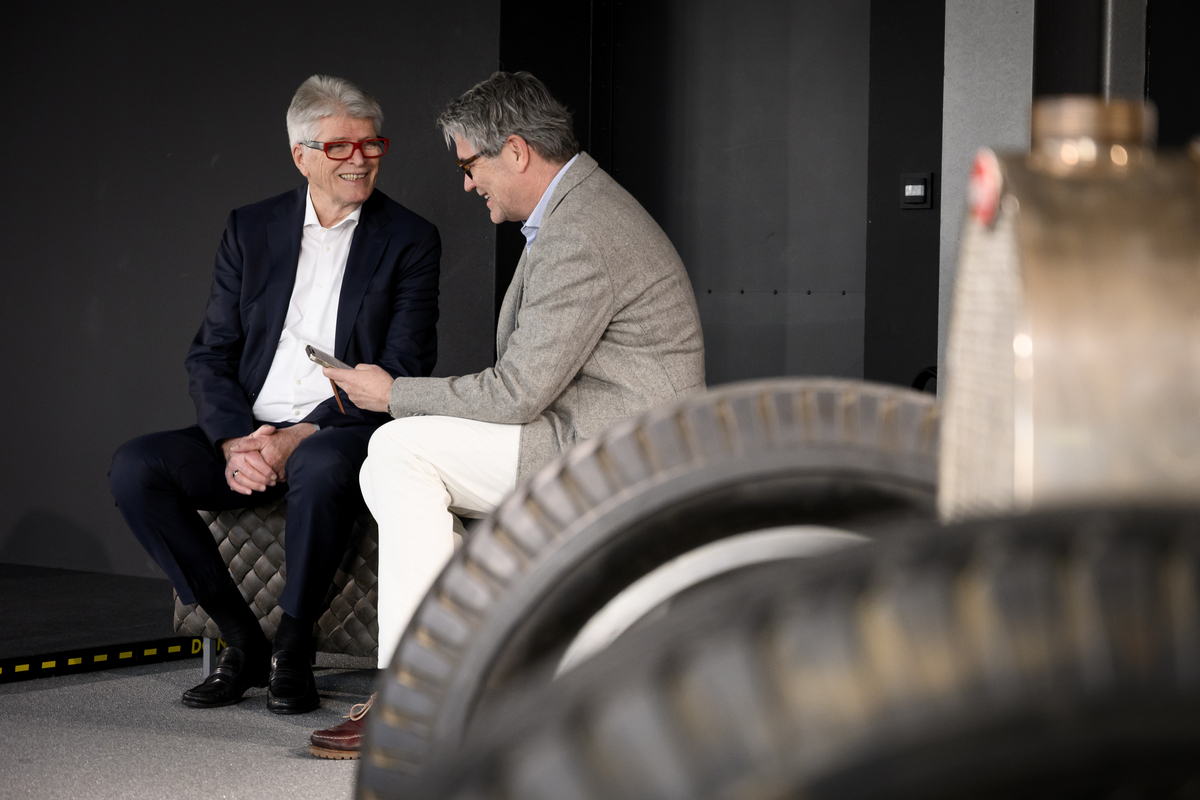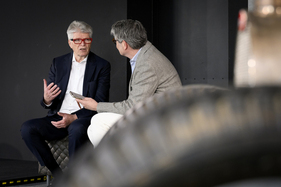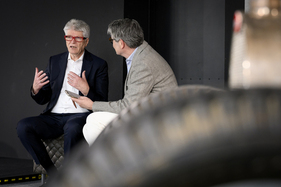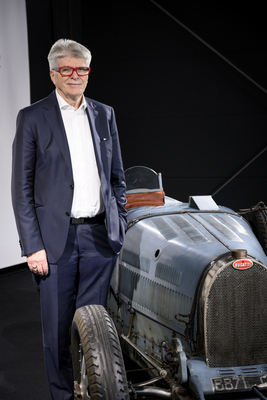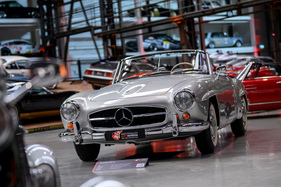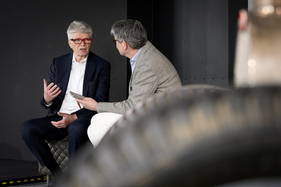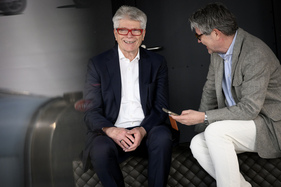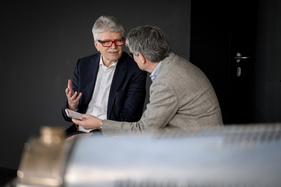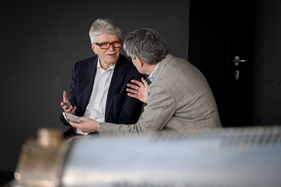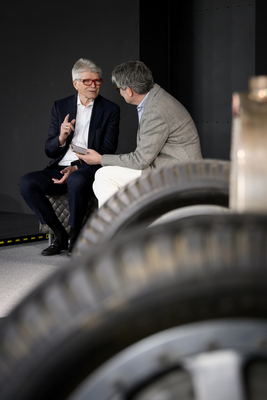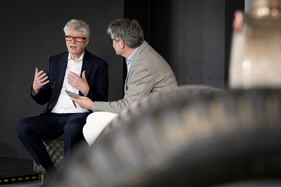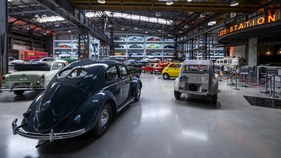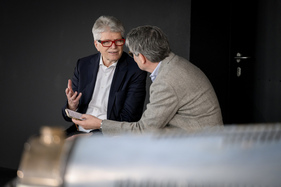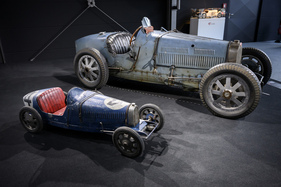On the occasion of the new " Grand Prix Icons" special exhibition , Zwischengas visited Professor Friedhelm Loh at the National Automuseum, who has built up a collection of historic automobiles and racing cars in the middle of the Hessian Siegerland region that is respected worldwide and is certainly one of the global "top 10".
He has achieved this over many years virtually "on the side", i.e. alongside his role as an active entrepreneur and boss of 13,000 employees or alongside his function as Vice President of the Federation of German Industries.
In the Zwischengas interview, he explains how it all began, why he did it and why he would do it again. The interview was conducted by Marcel Pelletier.
Zwischengas (ZG)
Good morning, Prof. Loh, and thank you very much for the opportunity to talk to you about the project close to your heart, the "Loh Collection" at the National Automobile Museum.
Mr. Loh, what was your first collector's item or the first vehicle that made you say to yourself: "Now I'm going to start collecting"?
Prof. Friedhelm Loh
When I was ten years old, I watched a friend of my father's drive up to our house in a brand new Mercedes-Benz 190 SL. And the silhouette of this car simply burned itself into my memory. So I said to myself: "If you ever can, you'll buy a car like that." And that's what I did later.
That was my first car. Then came the next one. I was very much a Mercedes collector at the time - plus a bit of Porsche. But at some point I came to the point where I said: "I've seen you all." Then I sold everything again and started all over again, but with a different goal!
ZG
But a 190 SL is now part of your collection again...
Loh
Yes, that's right. I bought another one, but a better one now. It's simply part of my history.
ZG
What was your goal when you started again, and what was your personal motivation for collecting historic vehicles?
Loh
I was fascinated by the technical history - not just of individual brands, but also internationally. What happened in the USA? What happened in Italy? What happened in England? I deliberately wanted to build up an international collection to show people the development of design in world history and the technology. The response - for which I am very grateful - is that the collection has been very well received.
ZG
If you look around your collection, you will discover many vehicles, most of which are very special in terms of their historical relevance. It's not just one model, but often "the" very special vehicle of a series that can be seen here. One could get the impression that your aim was and is to build up a collection that is particularly important in a global comparison?
Loh
That was never my goal. I bought cars more or less out of fascination, because I never had the idea of turning them into a museum. I wouldn't have bought another car if I had known earlier that it would one day be for a museum. It was always this special history of a car or the people behind it, who handled the cars and so on - that's what fascinated me, and that's how I became a bigger collector with some special vehicles.
And the idea for this museum is only seven or eight years old; it wasn't there before. But at some point I simply asked myself: is it good and useful if I only have an hour once a week or every 14 days to spend on my collection? And why should I be the only one to enjoy it? I'm still involved in a lot of voluntary work and companies and have very little time - it's just too bad for a collection like this to just gather dust somewhere.
ZG
So there is also a strong motivation to share your own passion for historic vehicles or to pass on your fascination for technological development?
Loh
Exactly that. Where we are sitting here was an industrial ruin, but with it also a great opportunity to transform it. And the people in this region are very close to my heart anyway. I would like to thank this region and the young people for what I have been able to achieve and experience together with them, and I hope that I can perhaps open some of their eyes to the details of automotive technology and motor racing history.
ZG
How do you select the cars? Do you have a team or a curator who supports you or with whom you consult, because for reasons of passion you certainly want to select them yourself? How does that work for you?
Loh
First of all, I am relatively spontaneous; a bit like other collectors. There are people who collect paintings, and you either jump on it and say "that's it" or not.
Every car in my life has had some kind of story that made me buy it. But it's like that: If you want to try to describe the story to some extent, then the story is not just about a brand, about a way of building cars. Instead, you have the normal road car; you have the representative car; you have the racing car; you have the DTMs; you have all sorts of things!
My aim was always to develop everything in a collection - initially just for me, but later also for the museum. And that has given this collection an additional sense of purpose - beyond just my enthusiasm - and I am grateful for that.
ZG
Is a certain completeness of "very relevant cars" a goal of your collection?
Loh
Well, completeness is not possible. Because what you see here are often rarities. There are still a few of them (editor's note: the exhibits in the new Grand Prix exhibition). Of course, there are many more cars of which there are only a few. And there are many more cars that have written a special story somewhere.
Somehow you try to find a common thread in the history of your own collection with the selected vehicles. And you can see that in the Formula 1 exhibition now. How did it all begin? How did it continue? Who were the people who developed this or that car? Who were the drivers without whom the cars would not have become winning cars?
This combination is actually extremely inspiring, because people - and this is an important point for me - people have gifts and talents. If they really use them, combined with a lot of will - like a Benz who just wanted to develop an engine, or Mr. Diesel or whatever - then you can make a big difference in this world! And that will be decisive for us in Germany in the future: How much enthusiasm, how much enthusiasm, how much willingness to take risks do we have in our country to survive in this international competition and be winners?
ZG
Was there a vehicle that you associate with a special story when you bought it? And are there strategies for "getting hold" of vehicles with a special history?
Loh
There are strategies, but fortunately there are also coincidences. Take the Bugatti 35, which is mentioned here again and again, the Monaco winner: it was previously in the Prince's Monaco museum. I never thought I would be able to acquire this car. But as is the case with many cars, there is a network of relationships somewhere that you don't necessarily have to know yourself and you can't know all the people involved.
There are many people who are known to know what is going on where and how in the market. And that's why what you see here is not an achievement on my part. Of course I made the final decisions. But it is an achievement of many people who were willing to work together to ensure that such a collection could be created over the years.
ZG
Do you know or are you in contact with other collectors? For example, have you ever visited Jay Leno or do you know any collectors in Switzerland?
Loh
Yes, I know a number - Louwman and so on. We know each other, but I think every collector - and this is evident in every collection - has his own thing somewhere, his own specialty. That's certainly the case.
ZG
And what is your thing - if you could explain it in one sentence?
Loh
Yes, that would certainly be internationality, technology, design and also education!
ZG
The educational aspect that you are pursuing is definitely worthwhile. There are said to be collectors who collect rather quietly and secretly in the underground garage or "for their ego", i.e. for the significance of their own person within a - at this level - quite small scene. What do you think of that?
Loh
Yes, it's not a bad thing that there are people like that. Otherwise some cars wouldn't be here today - they might simply have been scrapped. So I can completely understand that.
ZG
But you have a completely different motivation today?
Loh
Yes, this museum here is exactly my thing now; with a lot of joy and enthusiasm. We have partnerships with a technical college and a secondary school in the region. Professor Buck - a specialist in forensics - and Professor Henssler, who teaches design, support our ambitions to convey an interest in automotive engineering by means of historical development.
This is ten times more fun than walking through the halls on your own or even just showing a few friends that you have lots of cars. I'm happy when children's eyes are opened here and we pass on the flame a little. That's wonderful!
This is a very, very important issue for me, especially for the region here. And the other issue is education: How can I use a museum with historical technology and technological developments to inspire people to become more open to technology in general? Because I think it's an interesting and important vision for the future for young people to get more involved with technology.
ZG
Which of your cars means the most to you?
Loh
They all mean something to me, otherwise they wouldn't be here!
ZG
But there isn't one that makes you say: "I'm particularly proud to own it. That's what I'm most happy about."
Loh
You can take a lot of them: There's an Alfa Romeo 16C Bimotore over there, a one-off. Of course you can be proud that you have the one car that still exists in the world. So I like to answer this question a little differently by asking myself: What would be the last car to leave the collection if I had to sell it?
ZG
And?
Loh
That would be the Bugatti 35, this one in front of us, the winning car of the very first Monaco Grand Prix, because it simply turned everything on its head in terms of technology in its time. It starts with the size, the design of the engine. It continues with the speed of the pit stops, because the wheels, including the brakes, could be removed and quickly refitted. It's an amazing car. And with that patina.
ZG
It is indeed exceptionally beautiful. Fortunately, patina is increasingly being recognized. Last year, Fritz Burkhard won with his Type 59 at Pebble Beach - and it was the first winning car there with an original patina.
Is there a dream car that you have not yet been able to acquire? Or has it ever happened that you simply couldn't get your hands on it or were annoyed?
Loh
Well, I don't have this fanaticism. No, I simply don't have that. I always look at what opportunities are available. And if I can - it all costs money - then I do it. But I'm not someone who says "I have to have this or that car and I'll give anything for it" - no.
ZG
Here in your National Car Museum, you seem content and balanced. And yet the question is: would you take the same path again as a collector?
Loh
Well, there's no question that it's a learning curve. And I've learned a lot, I've been allowed to learn a lot. Of course, there are individual cars where you say to yourself "you didn't need to buy them. They're nice, but they haven't gained the significance you once expected from them." That doesn't bother me, and I would still do it again. The enthusiasm of the people walking through the museum confirms that I wasn't entirely wrong. And I enjoy it.
ZG
One last question about the future of the automobile. We all see and experience what is being created at the moment, and many people have the feeling that cars are becoming more and more an object of pure utility that has to get you from A to B - intentionally without emotion, because the cars are no longer designed for this purpose. How do you see this development? Will cars take on a completely different status than in the last century?
Loh
Of course they will have a different status. Like many other things that were once rather exotic and then became part of normal life. And that's why there are mass manufacturers. The first vacuum cleaners and washing machines also looked different. Until they became a product that was accessible to everyone - which is great, because that's what makes us prosperous.
And the more people can afford cars or any kind of vehicle or means of transportation to get from A to B, the better it is. You can only say "Thank you for that" - whether it's the train, the bus or your own car.
Freedom of mobility is actually the headline above all else. I believe this was also the motivating factor for many inventors.
I hope that we have many more people in our country who associate the topic of freedom with technology, with technological possibilities and with prosperity. Work as the basis for prosperity, performance-oriented prosperity. That is also what is ultimately most satisfying. That's what I want - and there will probably be nuances and alternatives as to which car you drive. But the idea of freedom is important, and the car embodies the freedom of the individual.
ZG
Thank you very much, Professor Loh. What you have created is a dream come true for many collectors. And thank you for the generous gesture of making your collection available to everyone at great effort and additional cost. This is a gift to the public.
Loh
I have to thank you for your visit. We look forward to seeing all Zwischengas readers here with us in the beautiful and centrally located Dietzhölztal.
